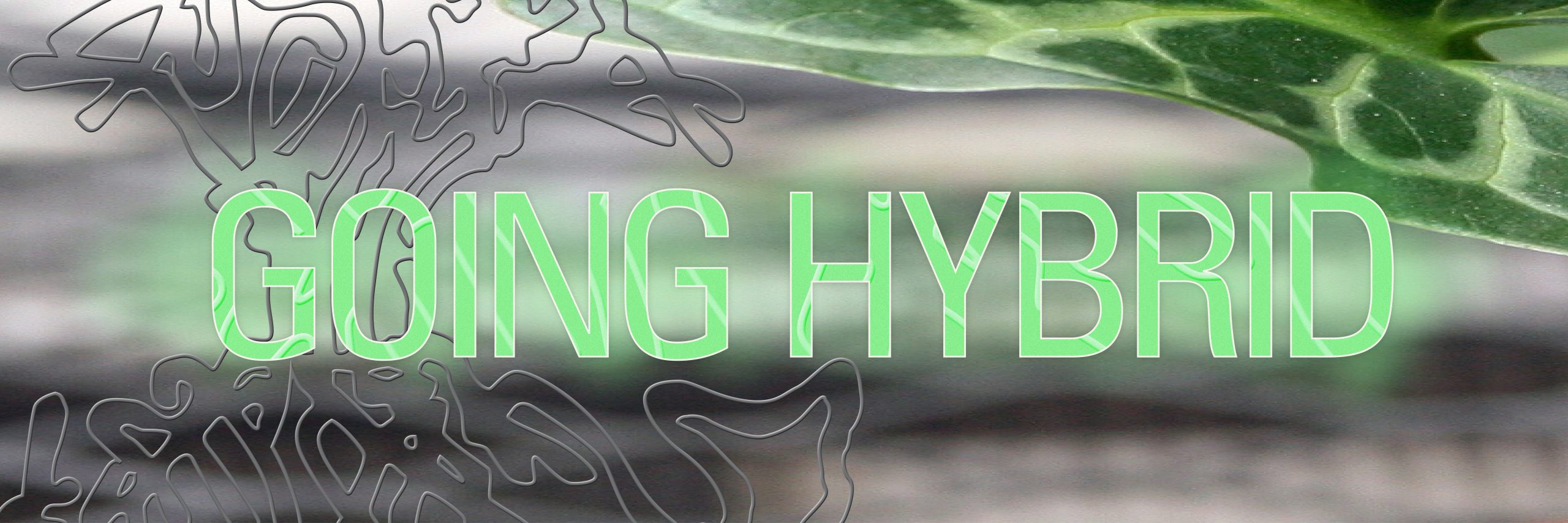Who Reads Event Reports?
It’s a daunting question, especially for someone who has written such a considerable amount of them. On most occasions, writing one feels like a mere necessity to justify received funding, an institutional obligation. On rare occasions, someone manages to break the format and create something momentarily interesting. But in reality, the majority of these reports read like the leftovers of an all-you-can-eat banket dinner, a patchy and chewed-out reminiscence of something you probably missed for good reasons, to begin with.
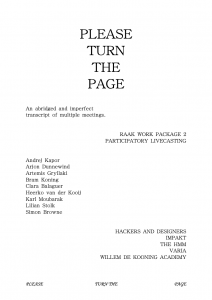
‘Please Turn the Page’ by Clara Balaguer, one of the rare occasions that event report conventions are interestingly broken. Read the entire report here: https://networkcultures.org/goinghybrid/2023/03/15/please-turn-the-page/.
Nevertheless, I’d like to take a stance in defense of the event report. These past years the cultural sector seems to be stuck in an overhaul. The quantity of events organized in and by cultural institutions is staggering. Openings, symposiums, workshops, artist talks, and conferences follow each other in rapid succession. Each one puts an even more important matter on the agenda than the previous one. More often than not these events position themselves as offering a start. Which can mean anything from A start to a conversation, a first look, an introduction, the beginning of a systematic rethinking… A start without offering any means to continue.
It seems that most of the cultural institutions are so busy organizing events, that the movements they aim to set in motion become an afterthought. This becomes painstakingly clear through the event report. Often reduced to a 12-hour-long recording of the live stream on YouTube, with no means to decimate any of the information. Sometimes the interested second-rate audience is blessed with an automated transcription, allowing one to scrape through some of the content. And very very rarely, a written report is published.
Within our research group, we came to the conclusion that if you dare to offer any start, thinking about what comes after is actually the bare minimum.
Of course, we realize this is not a particularly easy task. Many of us being cultural workers ourselves, we know the struggle to stay relevant whilst running on next to no funds all too well. In most cases, it’s not the lack of motivation, but a lack of means that creates the barrier to continue.
What Role Can Hybridity Play in This?
Going Hybrid is a 24-month-long research project into the future of hybridity in the cultural field. Where will hybrid events take us? Which platforms are best practices to host a cultural event without Zoom fatigue? How can hybrid publications be developed, or even living archives, sharing these experimentally broadcasted events with a (potential) audience? The research project will look at hybridity in the cultural field within three domains: hybrid events, living archives, and hybrid publications. Our research group has done a deep delve into hybrid publications. More specifically, hybrid event reports. You can read a longer introduction to the Hybrid Pubs Research Group here.
Whilst thinking about the durability and aftermath of cultural events, we set out to analyze the event report and its workflow:
- We made an overview of relevant tools and practices;
- We mapped the event report creation workflow and discussed possible experiments;
- And we created a taxonomy of elements that make event reports worth reading.
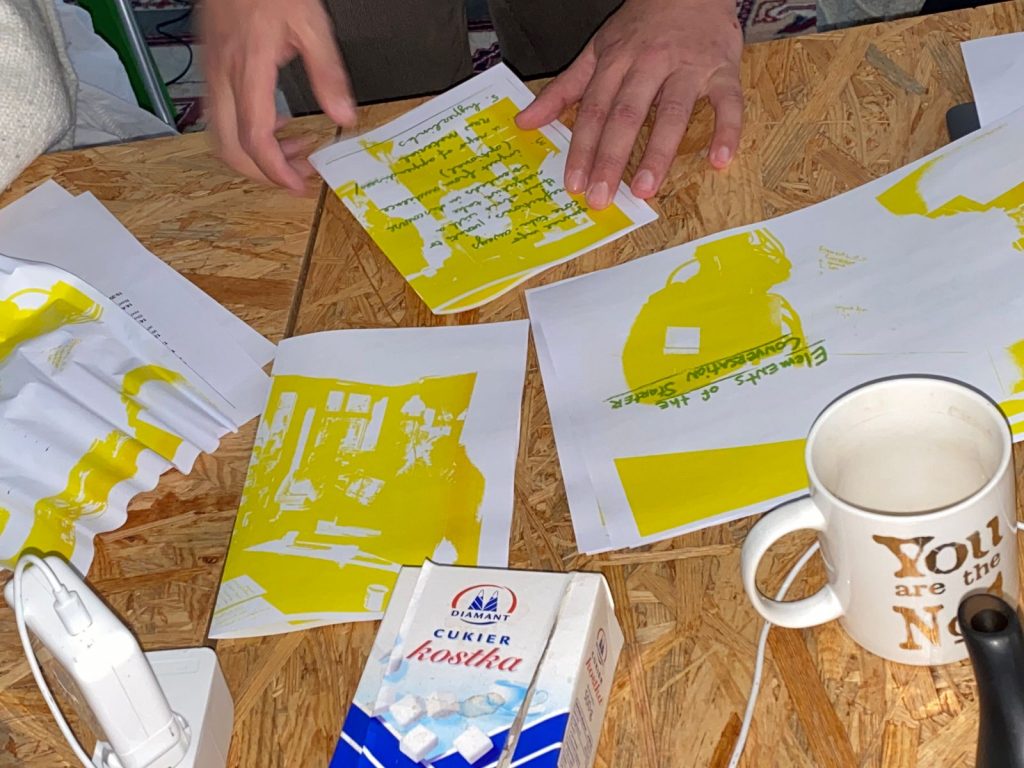
During a sprint day at Varia (Rotterdam), we created a content taxonomy of relevant content types and instantly published the results in a minizine using a riso printer.
Currently, our main objective is to find new cultural and digital strategies that expand the room for reflection and collectivity, with the use of alternative ways of online publishing. In this process, we were keen to experiment with making event reports can more open-ended, multi-voiced, and non-linear. Instead of creating FOMO-inducing descriptions, or bureaucratic documents, we wanted to create a structure for event reporting that would give readers an interesting, explorative experience. This research culminated in a structured tool-workflow combination that helps within the process of harvesting relevant information during and after events, while ideally empowering the reporter as an artisan and reducing the workload for the editors and producers.
But How Do We Take This Beyond Our Etherpads?
The tool we currently have is extremely simple and low-tech. It is a template on Etherpad that allows several people to take notes and jot down observations and helps them in the process of creating a report. This tool was then successfully tested during the conference In-Between Media: Hybrid Tactics in the Crisis Era. The results can be read here.
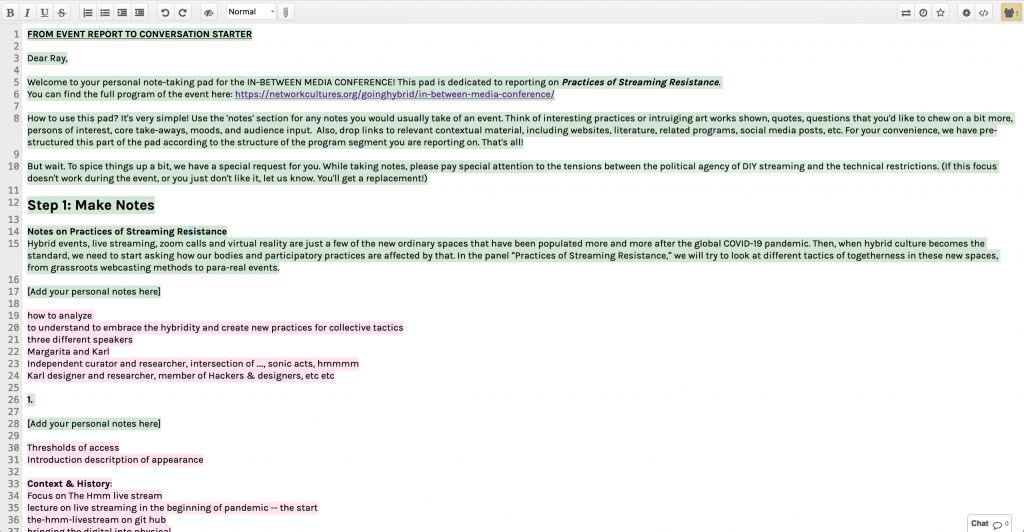
A little peek into the personalized event reporting pad of Ray Dolitsay.
But now we arrived at the interesting and tricky question of the tools. How to turn this workflow intervention into an experimental publication? We looked into several tools and platforms that might allow for hybrid workflows that can go from print to web and back again.
Octomode
https://git.vvvvvvaria.org/varia/octomode
Octomode is an experimental tool developed by Manetta Berends at Varia. The tool is used to make paged media publications collaboratively, in the browser using Etherpad, Markdown, and the JavaScript library Paged.js. Varia creates its hybrid newsletter SomeTimes using Octomode. We were initially excited about this tool, but when we tried to test it, the server that was running the instance we had access to went offline. As is often the case with experimental digital publishing tools, this one proved too unstable (reliant on the maintenance by a collective working in precarious circumstances) for wider use at this point.
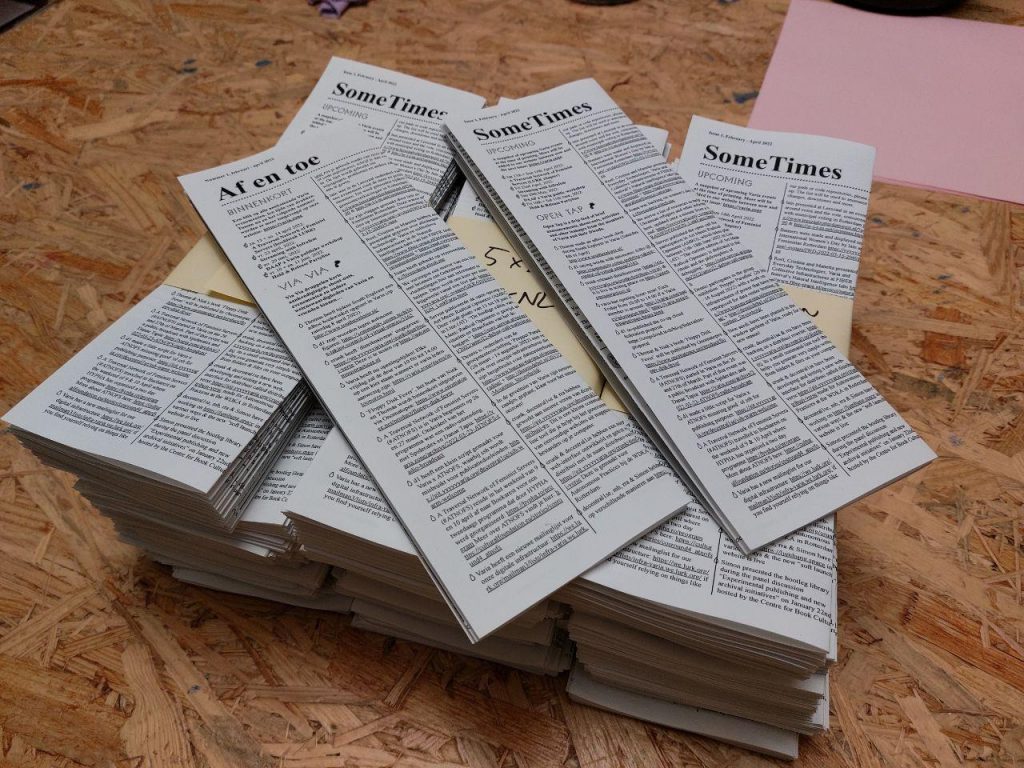
The printed version of SomeTimes / Af en toe, the bilingual hybrid newsletter by Varia created with Octomode.
pad2print
https://gitlab.com/Luuse/pad2print
Pad2Print is a collaborative web browser-based layout tool for printed documents. It uses pads on which you can edit the css and preview the double page in real time.
Twine
https://twinery.org
Twine is an open-source tool for telling interactive, nonlinear stories. Twine publishes directly to HTML, so you can post your work nearly anywhere. Anything you create with it is completely free to use any way you like, including for commercial purposes. The previous INC research project Making Public tested several non-linear publishing tools, and found Twine to be the most interesting. We also tested it and played around, but ultimately concluded that the most interesting dimension of Twine is its mind-map-like back-end interface – which is very difficult to translate to an interesting front-end publication.
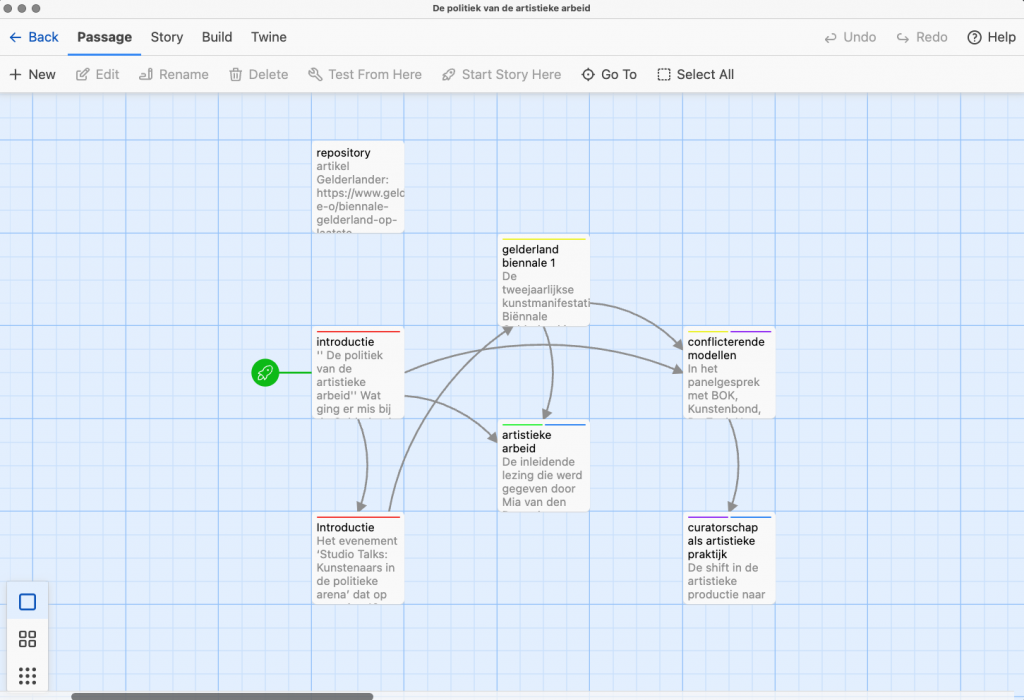
The interesting back-end view of an event report made non-linear in Twine.
Ethertoff
http://osp.kitchen/tools/ethertoff/
Ethertoff is a simple collaborative web platform, much resembling a wiki but featuring real-time editing thanks to Etherpad. Its output is constructed with equal love for print and web.
It quickly became clear that Ethertoff was the best option. It is the only tool that allows for real-time collaboration and perfectly integrates with the Etherpad structure from our previous research phase. It is also the tool with the most possibilities to design the visual output, whether pint or page. Also, we have the great benefit of having Gijs de Heij in our group, who is a member of the collective Open Source Publishing which created Ethertoff. (Open Source Publishing is a group of designers who question the influence and affordance of digital tools through its practice of (commissioned) graphic design, pedagogy, and applied research. They prefer to use exclusively free and open source softwares (F/LOSS). Currently, the group is composed of people with backgrounds in graphic design, typography, and development. Through its radical practice, Open Source Publishing questions the modes of collaboration between graphic designers and artists, between graphic designers and cultural institutions.)
A Closer Look at Ethertoff
In very rough terms, Ethertoff merges the functionalities of Etherpad and Wiki engines. Each Etherpad is published as a webpage within the wiki-like structure and is linked to other pads through hyperlinks. The output is a published website. The Etherpads within the structure are available to logged-in users (‘write-mode’). The text of the pad is available to everyone (‘read-mode’). This functionality allows for a hybrid, highly collaborative, and adaptable workflow. One in which the audience can engage. Its final output isn’t fixed but can grow and change when more events follow or conversations continue. It’s easily adaptable from web to print and back.
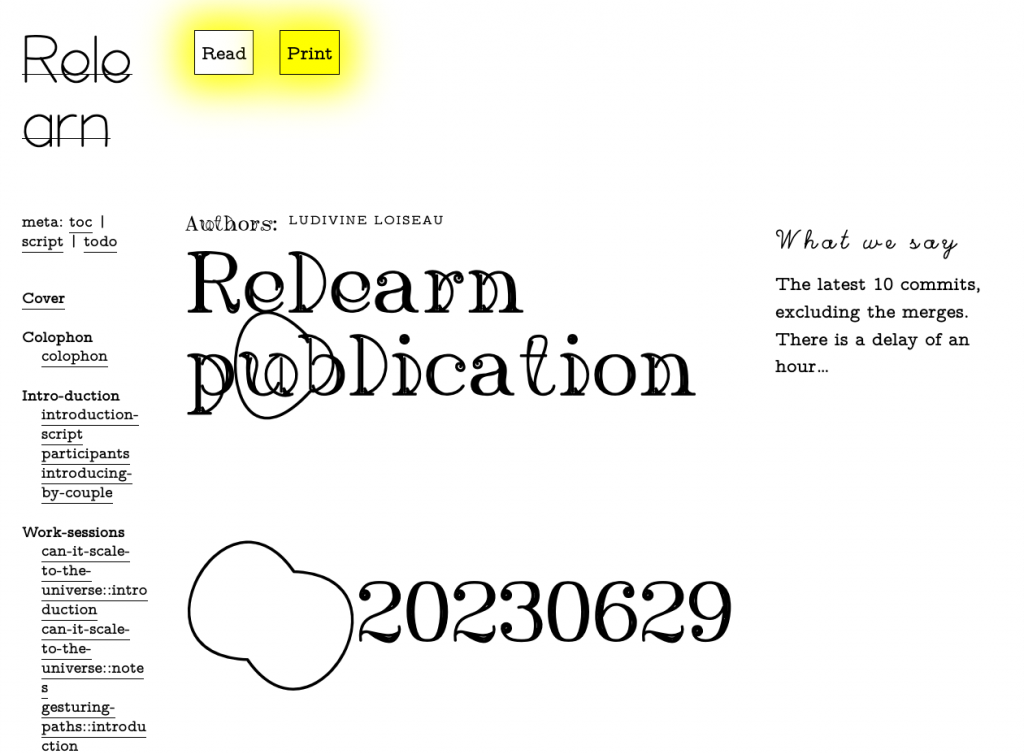
The website of Relearn 2013 was the first hybrid publication created with Ethertoff. Each link on the left-hand side represents an Etherpad, automatically turned into a web page using CSS.
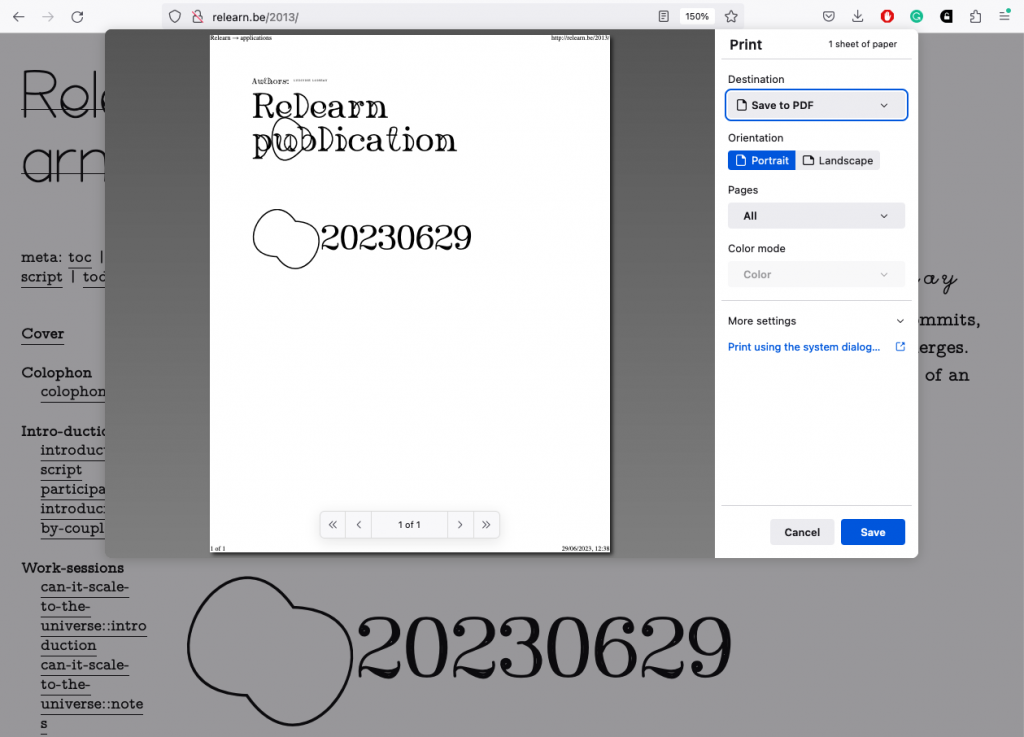
Each page on the Relearn 2013 website has a ‘print button’, automatically generating a printable PDF file based on the Etherpad and CSS. Try it out via https://relearn.be/2013.
Ethertoff has been initially developed for the OSP 2013 Summerschool bearing the name ‘Relearn’. The website of Relearn, which is still online, is the first instance of Ethertoff. Since then, OSP has developed several other stand-alone publications using Ethertoff, experimenting with different designs and features.
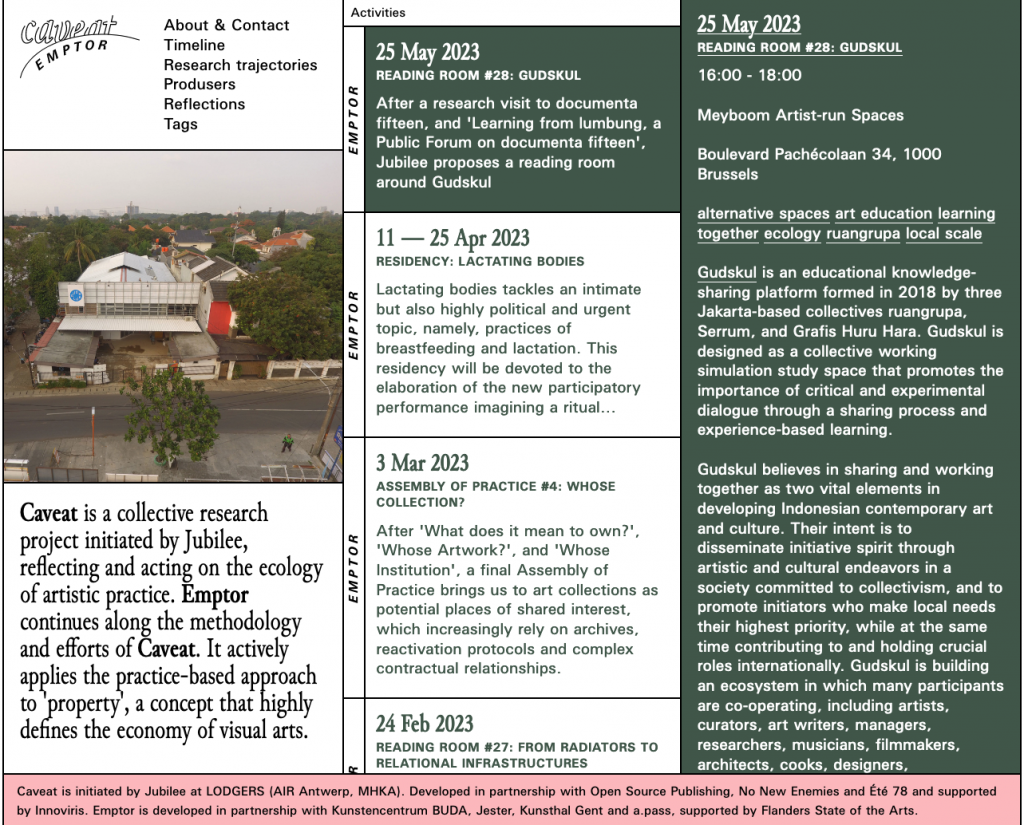
The website of the project Caveat & Emptor shows how different the template design can be, even though the same ‘patchwork’ of tools called Ethertoff was used to create it. You can explore the website via https://caveat.be/.
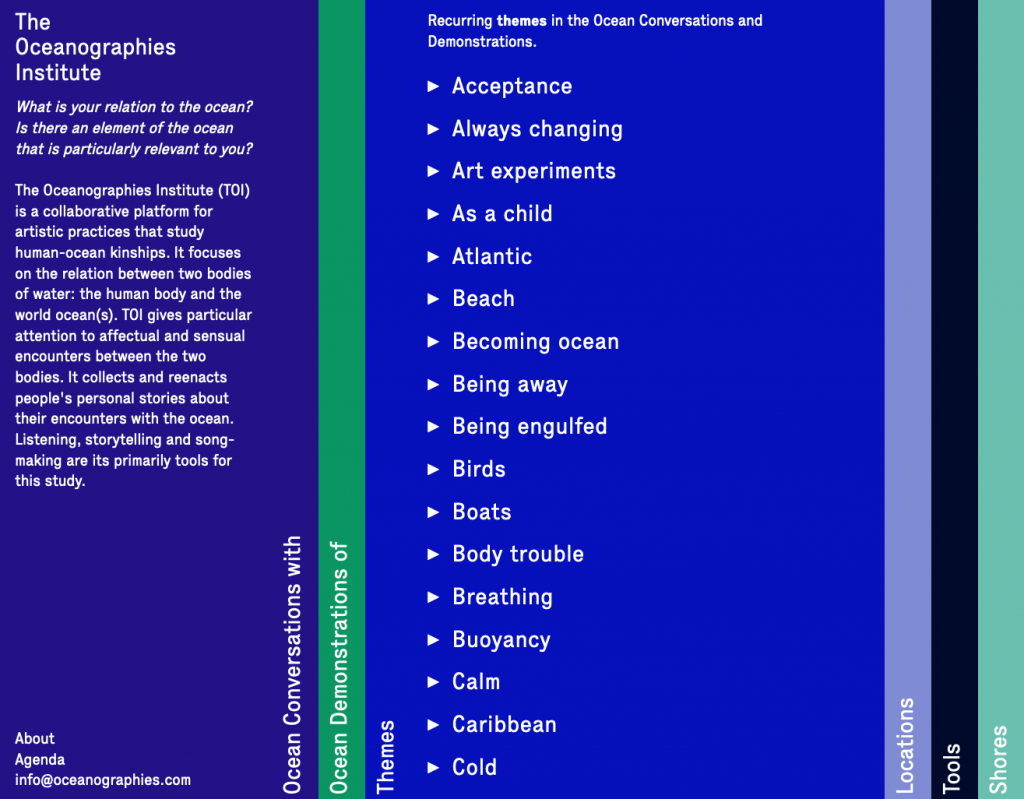
The website of Oceonagraphies was the first installation of Ethertoff to integrate a tagging system for paragraphs to create an extensive system of non-linear pathways between the different parts of the publication. See for yourself via https://oceanographies.com/.
Ethertoff is structured as a wiki where each page constitutes an Etherpad. For anyone not yet familiar with wikis; a wiki is an online publication that can be edited and managed collaboratively by its own audience, using a web browser. A typical wiki contains multiple web pages that are connected through hyperlinks. These web pages can be either open to the public or limited to use within an organization for maintaining its internal knowledge base. A Wiki is enabled by wiki software (a wiki engine), a form of a content management system. It differs from other web-based systems such as blog software, in that the content is created without any defined owner or leader, and wikis have little inherent structure, allowing structure to emerge according to the needs of the users.
Ethertoff is a shell for an Etherpad installation hosted on the same domain.
More information on its output and installation can be found here:
https://github.com/sfyn/django-etherpad-lite
http://osp.kitchen/tools/ethertoff/
The Hybrid Pubs Group Prototype
In the context of Going Hybrid, we are creating a new installation of Ethertoff. We are integrating the pre-structured event reporting pad and content tagging system developed during the editorial decisions, but we’re also taking the opportunity to develop Ethertoff into a more publicly accessible tool. Whereas all previous instances were created for stand-alone publications, the installation we will launch will facilitate multiple publications from multiple users and the creation and use of multiple templates. This way, it can grow to be a tool shared between cultural institutions and organizations.
We hope to soon be able to show you the first outputs of our experimentations. The final outcomes of our practice-based research will include a working prototype, along with a manual that will enable anyone interested to really go and try the tool for themselves.
References and Repository
Website OPS
http://osp.kitchen/about
Ethertoff links
https://github.com/sfyn/django-etherpad-lite
http://www.riotnrrd.info/tech/etherpad-lite-performances-ongoing-saga
http://www.thinkwemust.org/?page_id=6


